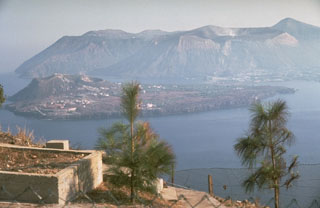Report on Vulcano (Italy) — 13 October-19 October 2021
Smithsonian Institution / US Geological Survey
Weekly Volcanic Activity Report, 13 October-19 October 2021
Managing Editor: Sally Sennert.
Please cite this report as:
Global Volcanism Program, 2021. Report on Vulcano (Italy) (Sennert, S, ed.). Weekly Volcanic Activity Report, 13 October-19 October 2021. Smithsonian Institution and US Geological Survey.
Vulcano
Italy
38.404°N, 14.962°E; summit elev. 500 m
All times are local (unless otherwise noted)
INGV continued to monitor elevated activity at Vulcano during 12-19 October. Scientists collected temperature, water chemistry, and gas-emissions data from four fumarolic vents located inside La Fossa Crater near the rim and from one vent near the beach. According to news articles, elevated levels of carbon dioxide impacted nearby residents in Porto Levante causing a few families to leave their homes on 13 October. Several residents had reported inexplicable illnesses and some deaths of domestic animals the previous week. On 14 October authorities restricted public access to the crater. The Dipartimento della Protezione Civile maintained the Alert Level at Yellow (the second lowest level on a four-color scale).
Geological Summary. The word volcano is derived from Vulcano stratovolcano in Italy's Aeolian Islands. Vulcano was constructed during six stages over the past 136,000 years. Two overlapping calderas, the 2.5-km-wide Caldera del Piano on the SE and the 4-km-wide Caldera della Fossa on the NW, were formed at about 100,000 and 24,000-15,000 years ago, respectively, and volcanism has migrated north over time. La Fossa cone, active throughout the Holocene and the location of most historical eruptions, occupies the 3-km-wide Caldera della Fossa at the NW end of the elongated 3 x 7 km island. The Vulcanello lava platform is a low, roughly circular peninsula on the northern tip of Vulcano that was formed as an island beginning more than 2,000 years ago and was connected to the main island in about 1550 CE. Vulcanello is capped by three pyroclastic cones and was active intermittently until the 16th century. Explosive activity took place at the Fossa cone from 1898 to 1900.
Sources: Sezione di Catania - Osservatorio Etneo (INGV), Dipartimento della Protezione Civile, la Repubblica, la Repubblica, la Repubblica

